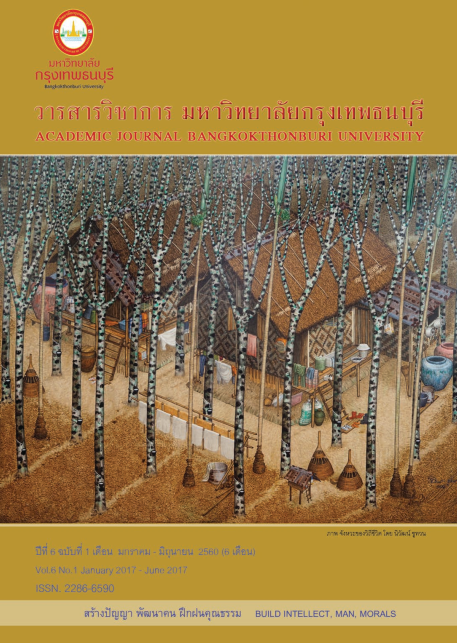อิทธิพลของปัจจัยเชิงสาเหตุต่อพฤติกรรมเอื้อต่อสังคมของนักเรียนอาชีวศึกษาเอกชนในกรุงเทพมหานคร
Main Article Content
บทคัดย่อ
การวิจัยครั้งนี้เป็นการพัฒนาโมเดลโครงสร้างความสัมพันธ์เชิงสาเหตุของพฤติกรรมเอื้อต่อสังคมของนักเรียนอาชีวศึกษาเอกชนในกรุงเทพมหานคร โดยมีวัตถุประสงค์เพื่อ 1)ศึกษาลักษณะพฤติกรรมเอื้อต่อสังคมของนักเรียนอาชีวศึกษาเอกชนในกรุงเทพมหานคร 2) ตรวจสอบความกลมกลืนของโมเดลปัจจัยเชิงสาเหตุที่มีต่อพฤติกรรมเอื้อต่อสังคมของนักเรียนอาชีวศึกษาเอกชนในกรุงเทพมหานคร 3) ศึกษาอิทธิพลของปัจจัยเชิงสาเหตุที่ส่งผลต่อพฤติกรรมเอื้อต่อสังคมของนักเรียนอาชีวศึกษาเอกชนในกรุงเทพมหานคร กลุ่มตัวอย่างที่ใช้ในการศึกษา คือนักเรียนอาชีวศึกษาเอกชนระดับประกาศนียบัตรวิชาชีพในปีการศึกษา 2559 จำนวน 902 คนโดยใช้วิธีการสุ่มแบบหลายขั้นตอน เครื่องมือวิจัยที่ใช้ในการเก็บรวบรวมข้อมูลคือแบบวัดปัจจัยเชิงสาเหตุที่มีต่อพฤติกรรมเอื้อต่อสังคมของนักเรียนอาชีวศึกษาเอกชน มีค่าความเชื่อมั่นที่ .96 สถิติที่ใช้ในการวิเคราะห์ข้อมูล ได้แก่ ค่าเฉลี่ย ค่าร้อยละ ค่าส่วนเบี่ยงเบนมาตรฐาน การวิเคราะห์สหสัมพันธ์แบบเพียร์สัน และการวิเคราะห์โครงสร้างความสัมพันธ์เชิงสาเหตุ
ผลการวิจัยพบว่า 1) ลักษณะพฤติกรรมเอื้อต่อสังคมของนักเรียนอาชีวศึกษาเอกชนในกรุงเทพมหานครประกอบด้วยการช่วยเหลือ การแบ่งปัน กิจกรรมการกุศล การให้ความร่วมมือ และการรักษาปทัสถาน2)ผลการตรวจสอบความกลมกลืนของโมเดลกับข้อมูลเชิงประจักษ์ในดัชนีกลุ่มสัมบูรณ์ พบว่าค่าChi-square (x2)= 45.00, df= 34, p=.10, ค่า GFI=.99, ค่า AGFI=.98, ค่า RMSEA=.01, ค่า SRMR=.01 ส่วนในดัชนีกลุ่มเปรียบเทียบ พบว่า ค่า CFI=1.00 เมื่อพิจารณาตามเกณฑ์ความกลมกลืน พบว่า ค่าChi-square (x2) ไม่มีนัยสำคัญทางสถิติ และดัชนีอื่นๆ ชี้ให้เห็นว่าโมเดลตามสมมติฐานมีความกลมกลืนกับข้อมูลเชิงประจักษ์ 3) อิทธิพลทางตรงสูงสุดของปัจจัยเชิงสาเหตุที่ส่งผลต่อพฤติกรรมเอื้อต่อสังคมของนักเรียนอาชีวศึกษาเอกชนมาจากปัจจัยด้านคติรวมหมู่ มีค่าอิทธิพลทางตรงเป็นบวกเท่ากับ .29 รองลงมาเป็นปัจจัยด้านหลักการนิยม ปัจจัยด้านความเอื้อเฟื้อ และปัจจัยด้านประโยชน์ส่วนตน มีค่าอิทธิพลทางตรงเท่ากับ .28, .22 และ .16 ตามลำดับจากค่าสัมประสิทธิ์พยากรณ์ พบว่าทั้ง 4 ปัจจัยเชิงสาเหตุสามารถร่วมกันอธิบายผลของพฤติกรรมเอื้อต่อสังคมของนักเรียนอาชีวศึกษาเอกชนได้ร้อยละ 62(R2 = .62)


